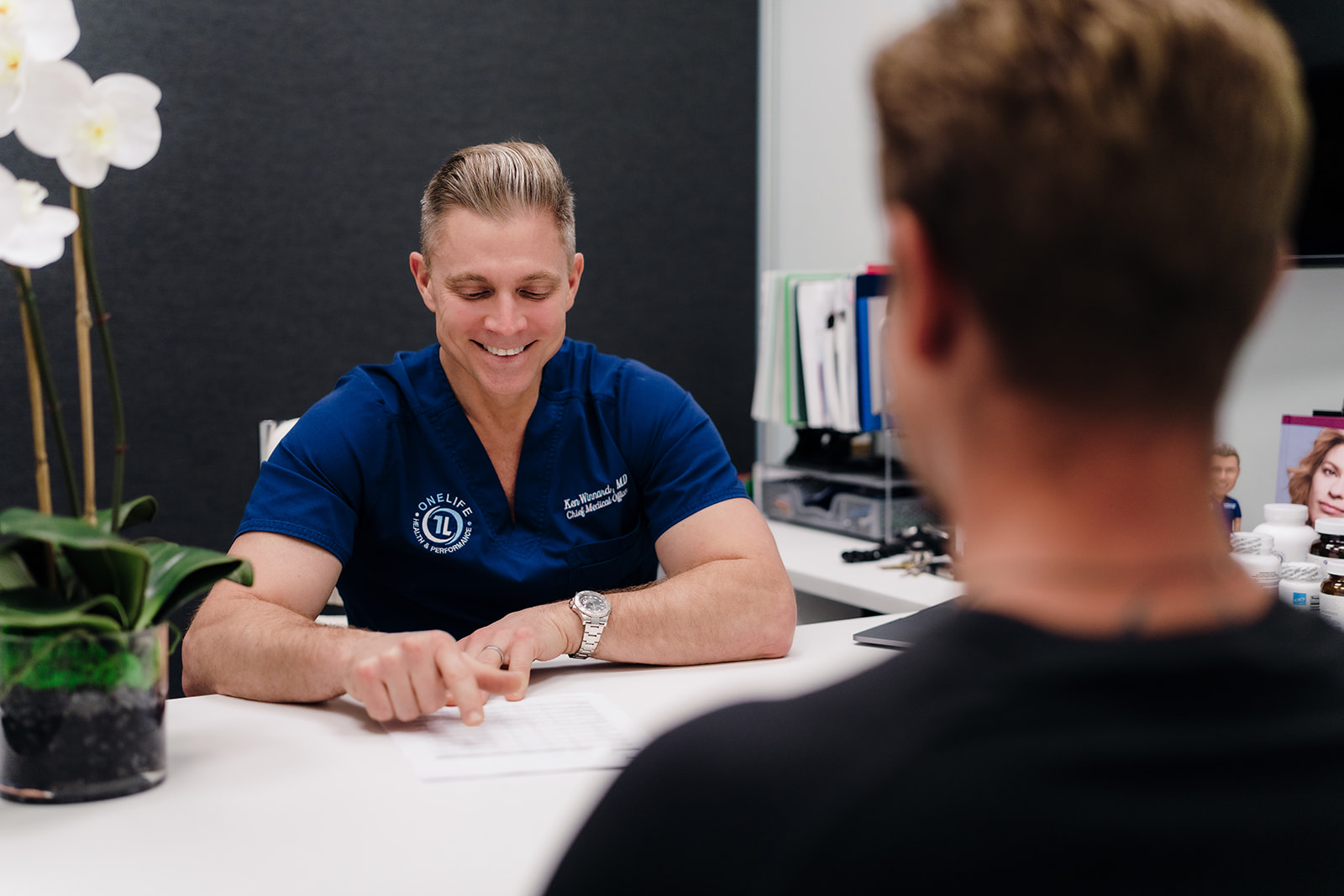The Truth About 'Low T': When Hormone Therapy Makes Sense
Understanding the truth about low testosterone and when treatment is the right choice.

Walk into any men's health clinic and you'll likely walk out with a testosterone prescription, regardless of your actual hormone levels or symptoms. The "Low T" industry has exploded into a billion-dollar business that often prioritizes profits over proper medical care, leaving many men confused about when testosterone therapy is actually beneficial versus when it's unnecessary or potentially harmful.
The reality is that testosterone deficiency is a legitimate medical condition, but it's also significantly overdiagnosed and overtreated. Understanding the difference between marketing-driven "Low T" treatment and evidence-based hormone therapy could save you from unnecessary risks while ensuring you get appropriate care if you actually need it.
Separating Real Hypogonadism from Marketing Hype
Clinical Hypogonadism vs. "Low T" Marketing True testosterone deficiency (hypogonadism) is a specific medical condition with clear diagnostic criteria. It requires both low testosterone levels AND clinical symptoms that significantly impact quality of life. Many "Low T" clinics skip the symptom assessment entirely, treating numbers rather than patients.
The Normal Range Reality Testosterone levels naturally decline with age—about 1-2% per year after age 30. This normal aging process doesn't automatically constitute a disease requiring treatment. The push to treat all men with testosterone levels below arbitrary thresholds has medicalized normal aging while ignoring individual variation.
Symptom Overlap Problems Many symptoms attributed to low testosterone—fatigue, mood changes, decreased motivation, weight gain—have multiple potential causes including sleep disorders, depression, metabolic dysfunction, and lifestyle factors. Jumping straight to hormone therapy without investigating other causes often misses the real problem.
The Reference Range Confusion Laboratory "normal" ranges for testosterone are statistical averages, not optimal levels for individual men. A man with naturally high testosterone who drops to the "normal" range may experience symptoms, while another man may feel fine at lower levels. Context matters more than numbers alone.
Proper Diagnostic Criteria
Laboratory Testing Requirements Accurate testosterone diagnosis requires multiple blood draws, preferably in the morning when levels peak naturally. A single low reading doesn't justify treatment—testosterone levels fluctuate based on sleep, stress, illness, and other factors.
Free testosterone and bioavailable testosterone often provide better clinical correlation than total testosterone alone. Many men with "normal" total testosterone have low free testosterone due to elevated sex hormone-binding globulin (SHBG).
Essential Additional Testing Comprehensive evaluation includes luteinizing hormone (LH) and follicle-stimulating hormone (FSH) to determine if low testosterone originates from testicular problems (primary hypogonadism) or brain signaling issues (secondary hypogonadism). This distinction significantly impacts treatment approach.
Prolactin levels should be checked, as elevated prolactin can suppress testosterone production. Thyroid function testing is essential since hypothyroidism can mimic low testosterone symptoms.
Clinical Symptom Assessment Validated questionnaires like the Androgen Deficiency in Aging Males (ADAM) scale help objectively assess symptoms. However, these tools supplement rather than replace thorough clinical evaluation and should never be used in isolation.
Red flag symptoms requiring immediate evaluation include loss of body hair, hot flashes, infertility, or gynecomastia (breast development), which may indicate more serious underlying conditions.
Lifestyle Factors That Affect Testosterone
Sleep and Testosterone Production Poor sleep quality dramatically impacts testosterone production. Men averaging less than 5 hours nightly can experience 15% testosterone reductions. Sleep apnea, common in overweight men, creates a cycle where low testosterone contributes to weight gain and sleep problems.
Body Weight and Composition Obesity significantly suppresses testosterone through multiple mechanisms. Fat tissue converts testosterone to estrogen via aromatase enzyme activity. Weight loss can restore testosterone levels naturally in many overweight men without requiring hormone therapy.
Stress and Cortisol Chronic stress elevates cortisol, which directly suppresses testosterone production. High-stress lifestyles, common among executives and professionals, can create functional hypogonadism that resolves with stress management rather than hormone replacement.
Exercise Patterns Both too little and too much exercise can negatively impact testosterone. Moderate resistance training typically supports healthy testosterone levels, while excessive endurance training or complete inactivity can suppress production.
Alcohol and Substance Use Regular alcohol consumption, particularly binge drinking, significantly suppresses testosterone production. Opioid medications, even when prescribed appropriately, can cause severe testosterone suppression that persists long after discontinuation.
Evidence-Based Treatment Protocols
When Treatment is Clearly Indicated Testosterone therapy makes sense for men with confirmed low testosterone levels (typically below 300 ng/dL on multiple tests) AND significant symptoms that impact quality of life AND no contraindications to treatment.
Primary hypogonadism due to testicular injury, cancer treatment, or genetic conditions typically requires lifelong testosterone replacement since natural production cannot be restored.
Treatment Options and Considerations Testosterone gels provide steady hormone levels but carry transfer risks to partners and children. Injection protocols (weekly or biweekly) avoid transfer concerns but create fluctuating hormone levels that some men find problematic.
Clomiphene citrate can stimulate natural testosterone production in men with secondary hypogonadism, preserving fertility while addressing symptoms. This approach works well for younger men or those planning families.
Starting Protocols and Monitoring Initial testosterone dosing should start conservatively with gradual increases based on symptom response and laboratory values. The goal is symptom relief, not achieving supraphysiological levels.
Regular monitoring includes testosterone levels, estradiol, hematocrit, prostate-specific antigen (PSA), and lipid profiles. Some men develop elevated red blood cell counts requiring dose adjustment or blood donation.
Monitoring Requirements and Safety
Essential Laboratory Monitoring Testosterone therapy requires ongoing medical supervision with regular laboratory monitoring. Hematocrit levels above 54% increase cardiovascular risks and may require treatment modification.
Estradiol levels may rise excessively in some men, potentially causing mood changes, water retention, or gynecomastia. Aromatase inhibitors can address this but require careful monitoring.
Cardiovascular Considerations The relationship between testosterone therapy and cardiovascular risk remains controversial. Some studies suggest increased risk, while others show neutral or beneficial effects. Men with existing heart disease require particularly careful evaluation and monitoring.
Prostate Health Monitoring While testosterone doesn't cause prostate cancer, it can accelerate existing malignancies. Regular PSA monitoring and prostate examinations are essential, especially for men over 50 or those with family history.
Fertility Impact Testosterone therapy typically suppresses sperm production, potentially causing infertility that may persist after discontinuation. Men planning families should explore alternatives like clomiphene or human chorionic gonadotropin (hCG).
When to Avoid Testosterone Therapy
Absolute Contraindications Prostate cancer, breast cancer, untreated sleep apnea, uncontrolled heart failure, and plans for pregnancy (partner) represent clear contraindications to testosterone therapy.
Relative Contraindications Elevated hematocrit, severe lower urinary tract symptoms, or poorly controlled cardiovascular disease require careful risk-benefit analysis and may preclude treatment.
Age Considerations Very elderly men may face increased risks without proportional benefits. Younger men with unclear hypogonadism may benefit from lifestyle modification or alternative treatments before considering testosterone.
Red Flags in Treatment Centers
Profit-Driven Practices Clinics that guarantee treatment regardless of initial testosterone levels, skip comprehensive evaluation, or push expensive proprietary formulations prioritize profits over patient care.
Inadequate Monitoring Proper testosterone therapy requires regular laboratory monitoring and clinical follow-up. Clinics offering testosterone without ongoing medical supervision violate standard care protocols.
Unrealistic Promises Claims of dramatic muscle gain, fat loss, or sexual enhancement beyond what's supported by clinical evidence suggest marketing rather than medical practice.
Making Informed Decisions
Getting Proper Evaluation Seek evaluation from qualified physicians who specialize in hormone therapy and follow evidence-based guidelines. Endocrinologists and experienced family medicine or internal medicine physicians often provide more balanced assessments than specialized "Low T" clinics.
Second Opinions If testosterone therapy is recommended, consider seeking a second opinion, especially if the diagnosis seems rushed or alternative causes weren't explored thoroughly.
Lifestyle First Approach Many men benefit from addressing sleep, weight, stress, and exercise before considering hormone therapy. These interventions may resolve symptoms while improving overall health.
Navigate Testosterone Therapy Safely at OneLife
The complexity of testosterone evaluation and treatment requires medical expertise that distinguishes between legitimate hormone deficiency and normal aging while ensuring safe, effective treatment when indicated. At OneLife Health & Performance in Palm Beach Gardens, Dr. Ken Winnard's approach to hormone therapy emphasizes comprehensive evaluation, evidence-based treatment protocols, and careful ongoing monitoring that prioritizes your safety and long-term health over quick fixes. Our assessment includes detailed symptom evaluation, comprehensive laboratory testing, and investigation of underlying causes before considering hormone therapy.
Whether you're experiencing concerning symptoms or questioning a previous "Low T" diagnosis, our expertise in hormone medicine provides the thorough evaluation and honest guidance needed to make informed decisions about your hormonal health.
Ready to get straight answers about testosterone therapy from a physician who prioritizes evidence over marketing? Schedule your comprehensive hormone evaluation today to discover whether testosterone therapy is appropriate for your specific situation and learn about all available options for addressing your concerns safely and effectively.

Subscribe to the newsletter
At OneLife, we believe that informed patients make empowered decisions. Our journal is your trusted source for expert insights, cutting-edge health strategies, and real-world advice on how to optimize your body, mind, and longevity.
.svg)


.svg)
.svg)
.svg)



